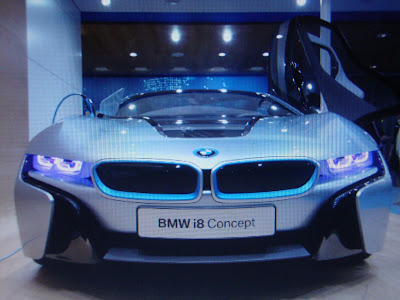Renault DeZir 2012
Renault DeZir is the first project to be led by Laurens van den Acker and marks the implementation of the strategy based on the notion of 'life cycle'. The first step involves falling in love, an experience that is perfectly illustrated by DeZir's powerful, sensuous styling and bright red finish; red being the colour associated with passion.
The result is a two-seater coupe which is both sculptural in spirit yet perfectly harmonious. DeZir's shape features prominent wheel arches that accommodate 21-inch wheels, the design of which took its inspiration from the notion of movement.
Renault DeZir's front end features a full-width air-intake which strikes out either side of a large, vertically positioned Renault logo that proudly displays the car's brand pedigree. Meanwhile, the chrome finish of the diamond-shaped logo contrasts with the dark aspect of the grille to express the statement still further.
DeZir is powered by an electric motor mounted in a mid-rear position to optimize weight distribution over the front and rear wheels. The vertically-mounted 24kW/h lithium-ion battery is located behind the benchseat and provides the car with a range of 160km.
Battery cooling is ensured not only by the air channelled from the front to the back of the car, but also – and above all – by the flow of air that enters through the lateral scoops concealed behind the aluminium panels on either side of the body.
The basic motor is the same as the unit used for Renault's production electric cars, although an evolution has enabled its power and torque to be uprated to 110kW (150ch) and 226Nm respectively.
Three battery-charging methods can be employed:
- a standard charge using a conventional household plug (fully charges the battery in eight hours).
- a fast charge using a 400V three-phase current (charges the battery to 80 per cent of its capacity in 20 minutes).
- a fast battery exchange thanks to Renault's Quick Drop technology.
Battery cooling is ensured not only by the air channelled from the front to the back of the car, but also – and above all – by the flow of air that enters through the lateral scoops concealed behind the aluminium panels on either side of the body.
The basic motor is the same as the unit used for Renault's production electric cars, although an evolution has enabled its power and torque to be uprated to 110kW (150ch) and 226Nm respectively.
Three battery-charging methods can be employed:
- a standard charge using a conventional household plug (fully charges the battery in eight hours).
- a fast charge using a 400V three-phase current (charges the battery to 80 per cent of its capacity in 20 minutes).
- a fast battery exchange thanks to Renault's Quick Drop technology.
Renault DeZir Concept Car Technical Specifications
- Motor: Electric synchronous motor with rotor coil
- Power: 110 kW / 150 hp
- Maximum torque: 226 Nm
- Top speed: 180 km/h
- Acceleration 0-100 km/h: 5 seconds
- Acceleration 0-50 km/h: 2 seconds
- Battery: Lithium-ion (24 kW/h)
- Range: 160 km
- Transmission: Rear-wheel drive; Direct, drive, with reducer and forward/reverse inverter
- Drive: Electric with active differential
- Chassis: Tubular steel frame
- Wheels and tyres: 245/35 R 21
- Diameter of ventilated brake discs: 356 mm (front and rear)
- Callipers: 6 pistons (front and rear)
- Cd (drag coefficient): 0.25
- Kerb weight: 830 kg
Overall Dimensions
- Length: 4,225 mm
- Width: 1,968 mm
- Height: 1,163 mm
- Height, with doors open: 2,256 mm
- Width, with doors open: 2,682 mm
- Ground clearance: 110 mm
- Wheelbase: 2,582 mm
- Front track: 1,600 mm
- Rear track: 1,705 mm
Renault deZir is Really sportcar with the best performance and the fastest car. Within the framework of the creation of an audio signature for the brand's upcoming electric vehicles, Renault has been working closely with the highly-regarded IRCAM (Institut de Recherche et Coordination Acoustique/Musique, founded by Pierre Boulez in 1969) to define the sound that best reflects DeZir's personality.


















